A NEW FRONTIER OF BELONGING
February 2022The 36-year-old Calvino fell fervently in love with New York, so much so that he wrote in one of his letters:
“Life in New York has started to become ferociously pleasant again. I must be daft, but I am more in love than ever with this horrendous city. New York is the only true love of my life.”
The honeymoon phase that never escaped the Italian writer, perhaps only intensified. The four short months spent in a foreign city that never became his residential home left in him an indelible longing. In an interview with literary critic Maria Corti, he crystallized his romantic vision of the city:
The city which I have felt was my own city more than any other is New York. [..] I wanted ‘New Yorker’ to be engraved on my tombstone.
… every time I go to New York I find it more beautiful and closer to the shape of an ideal city. It may also be the fact that it is a geometric, crystalline city, without a past, without depth, apparently without secrets; It is the city which intimidates me the least, the city which I can have the illusion of possessing in my mind, of being able to think about in its entirety all in the same instant.
Calvino’s love is passionate yet measured, recognizing that the illusion of “possessing” a city is only made possible by the lack of visibility into all of its historical context, which allows for the formation of a subjective “entirety”. Being a tourist that lacks certain context doesn’t make his love for New York any less valid than that of a native.
The 22-year-old writer James Baldwin left New York after his friend committed suicide throwing himself off the George Washington Bridge. It wasn’t a matter of preference, but a matter of survival in a country where he felt his existence had become a threat. Baldwin boarded the plane to Paris in 1948 with just 40 dollars in his pocket. He looked out the window over the outline of Paris and was sure he was going to be “dashed to death on the vindictive tooth of the Eiffel Tower.”
The “vindictive tooth” ended up becoming a guiding beacon that attracted intellectual and creative exiles from all over the world. Baldwin didn’t get “dashed to death” in Paris, but rather established a glorious writing career and vibrant social life, yet not without a permanent sense of loss and homesickness.
 Cafe de Flore
Cafe de FloreIn the afternoons, Baldwin would set off to Saint-Germain-des-Prés, where he spent time on the second floor of the Café de Flore and began writing Go Tell It on the Mountain and rough drafts of Notes of a Native Son.
He wrote fondly of Paris: “walking through the markets, singing, loving every inch of France… and each other… the jam-sessions in Pigalle, nights spent smoking in the Arab cafés, ending at dawn, telling stories, sad and earnest stories in grey, workingmen’s cafés.”
People who have found themselves and felt seen for the very first time in Baldwin’s prose retraced his footsteps in Paris. Writer Ellery Washington visited Paris to celebrate the 50th anniversary of Baldwin’s arrival:
Seduced by the idea of chasing Baldwin’s literary coattails, I dedicated myself to rereading “Giovanni’s Room,” allowing the texture and mood of Baldwin’s (and Giovanni’s) Paris to overlap with the version of the city I was newly discovering.
Even a city that defined Baldwin’s writing career and his identity as a writer failed to diminish his longing for home. He spent the final chapter of his life in a village near Nice, in a farmhouse overlooking the ocean where he can dream. Every decor in the farmhouse was linked to America, such as photos and paintings of Harlem.
One man’s home can be another man’s longing. One man’s exile can be another man’s pilgrimage. No one has articulated the amorphous identity of locality better than Polish novelist Olga Tokarczuk: “to someone from nowhere, every movement turns into a return.”
Nation states impose borders, stories erode them. Institutions design boundaries, human bondage destroy them. The vivacity of West Village, New York mirrors that of Marais, Paris. The unapologetically colored hairs of youth in Shibuya, Tokyo is reminiscent of those found in underground bars in Sanlitun, Beijing. It’s through the diversity of social fabric and creative activities that a city becomes a symbol, a myth, an idea that can take on a life of its own and permeates the collective psyche through the process of mimesis.
Imagine a photographer who decided to spend the night in a speakeasy in Bushwick might order the same Japanese Whiskey as a game designer in Ginza. They both like the band Godzilla and they long for a dirt-biking trip in Mexico. They’re both fans of Blade Runner and would like to fall asleep reading Greg Egan. They enjoy the simplicity of a Uniqlo shirt and the tantalizing sound of cold brew pouring over a glass of ice cubes. They might have debated with one another in a Reddit thread, might have commented on the same video on Youtube, might have followed similar accounts on Twitter and Instagram. They might have even shared a dream — to create a digital archive that features all the forgotten designers that propelled the invention of everyday objects.
They didn’t speak one another’s language, but does that matter? If they ever met in real life, let’s say, in a small town in Greece where they both chose to spend their summers, will they recognize that they are so different but the same and that they belong to a place together? Will they see the other as a New Yorker or a Tokyoite? Will they return to their respective hotel rooms with an ocean view, wondering how they felt the longing for a nonexistent homeland?
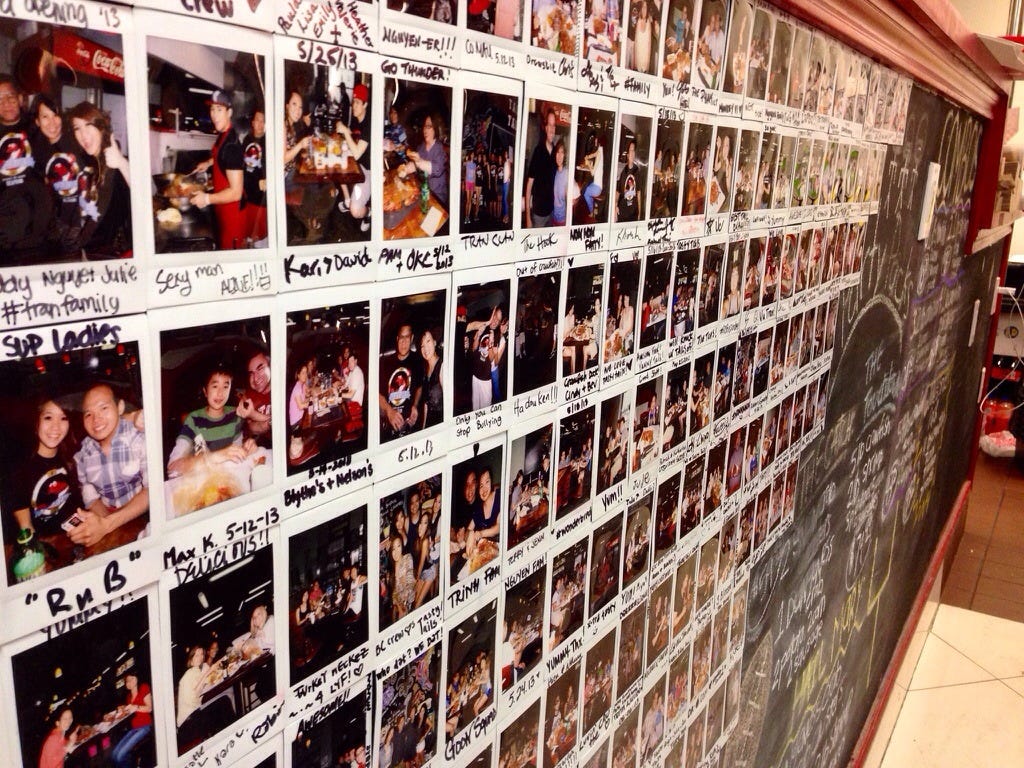
The Internet challenged the idea of a “place” since the very beginning and has done so at an accelerated rate with the advent of AI. The platforms’ algorithm effectively sorts people into invisible towns, and channel goods and services to the towns that’d need them the most. The invisible place that the New York photographer and the Tokyo game designer reside in, if made visible physically, consists of hundreds of thousands of people going about their day around the world. Without ever physically interacting with one another, they are all “hyperlocal” to the same “place”.
The concept of “locality” started collapsing online slowly at first, then suddenly. Local places were first migrated online quite literally by companies like Yelp, Foursquare, and NextDoor. The crowdsourced reviews and ranking system transformed the relationship between people and places. Nextdoor magnifies the stark reality of American neighborhoods by creating a hyperlocal town hall sprinkled with gestures of kindness, doses of heartfelt absurdity, while flooded with urgent alarms of dog poops, snowstorms, and racially charged complaints. With Yelp, it becomes easy to find the most popular sushi restaurant within 5 miles and crown category leader by simply following the wisdom of the crowd. Foursquare takes discovery one step further and enriches physical infrastructure with digitally native interactions like the ability to see a friend who “checked in” at the place and left a “tip”.
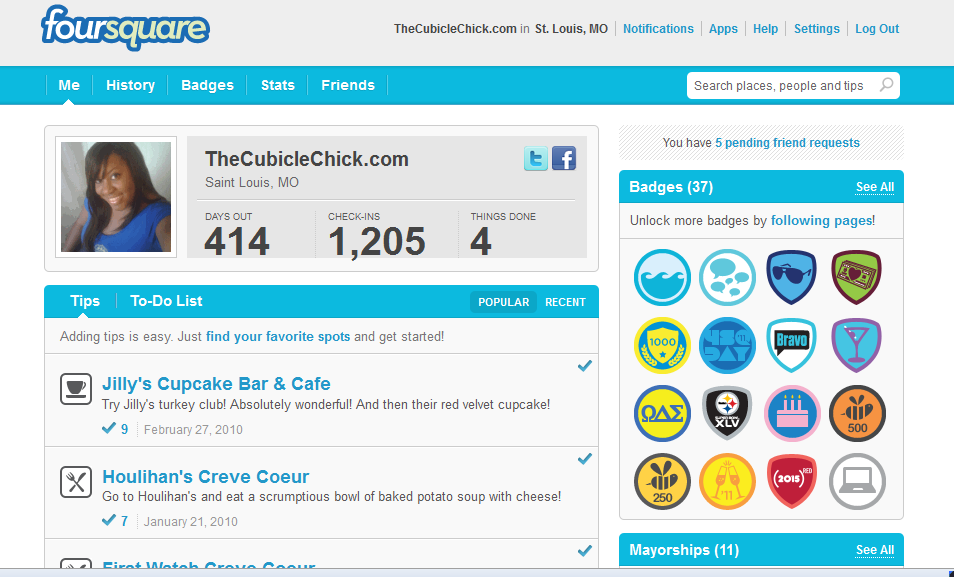 The Cubicle Chick
The Cubicle ChickAt its height, Foursquare’s 50 million users indulged in healthy competition and camaraderie between one another. They get points for leaving tips, get badges for checking in, and get mayor status if they checked into a certain venue on more days than anyone else in the past 60 days. However, the heightened engagement from gamification didn’t outlast the lack of continuous value beyond the initial dopamine rush.
Yelp knows better when it comes to treating its power users like true VIPs.
 Yelp
YelpIt wasn’t too long ago when being a Yelp Elite was considered a sought-after status by many. The New York Times wrote a piece on the phenomena in 2008:
“It’s kind of like a cult, except instead of Kool-Aid we drink alcohol,” said Su Kim, of Laurel, Md., who is known as the Washington area’s “Primemeatiser” because he holds carnivore-only events.
He started a talk thread with the words, “You know you’re addicted to Yelp when ... ” The answers included: “ ... when you go to a restaurant for the sole purpose of adding to your review count, not because you’re hungry,” “ ... when you hate going abroad because you can’t Yelp about all your wonderful finds” and “... when you’re dining with non-Yelper friends and they ask, ‘Are you Yelping this in your head?’ ”
These Elite Yelpers elicit poignant criticisms from celebrity chefs like Anthony Bourdain who openly despised the flippancy of this new piece of technology, whose users, in the master’s eyes, have little regard for cultural context or craftsmanship. He explicitly chastised them in an interview:
There’s really no worse, or lower human being than an elite Yelper... They’re universally loathed by chefs everywhere. They are the very picture of entitled, negative energy. They’re bad for chefs, they’re bad for restaurants. You know, you open a restaurant, you struggle for a year to put together the money, you work your heart out, and then 10 minutes after opening, some miserable b-stard is tweeting or Yelping, ‘Worst. Dinner. Ever.'
It’s usually fear that breeds anger. The prolific Yelpers and reviewers have left an irreversible dent in the restaurant industry. The helpless masters from the previous generation could only stand there and see how the wall came down. During Yelp’s cultural peak in 2011, one study showed that independent restaurants that see a one-star bump in their Yelp rating also see a significant jump in revenue. Another study indicated that even just a half-star increase means a restaurant is much more likely to be full at peak dining hours.
Yelp became a place where people find their identity as an arbiter of local taste, and by fully internalizing such identity they meet others who feel the same way. They actualize such identity by pouring hours of labor to create content without any compensation besides the Elite status, which entails free access to exclusive events where fine dining and good wine are served. The higher you climb up the Elite tier, the higher quality the events and the people. According to this Quora answer from a veteran Elite:
It pays to be an Elite for many years. Most Elite events are for any Elite but in the bigger Yelp cities they can be even more exclusive. There can be events restricted to just Gold Elites and they are beyond epic. There are even events for just Black Elites and they are over-the-top amazing!
Such an explosion of crowdsourced content on the Internet inspired technologists and entrepreneurs to push the boundaries of what these digital places can do. Now they want to break from the constraints of the physical infrastructure entirely, and no longer be constrained by hours of operations, the radius of transportation, and the labor required for maintenance. They not only want to bring the physical locations online but to shape the physical world with the sheer force of the collective desire of Internet users around the world.
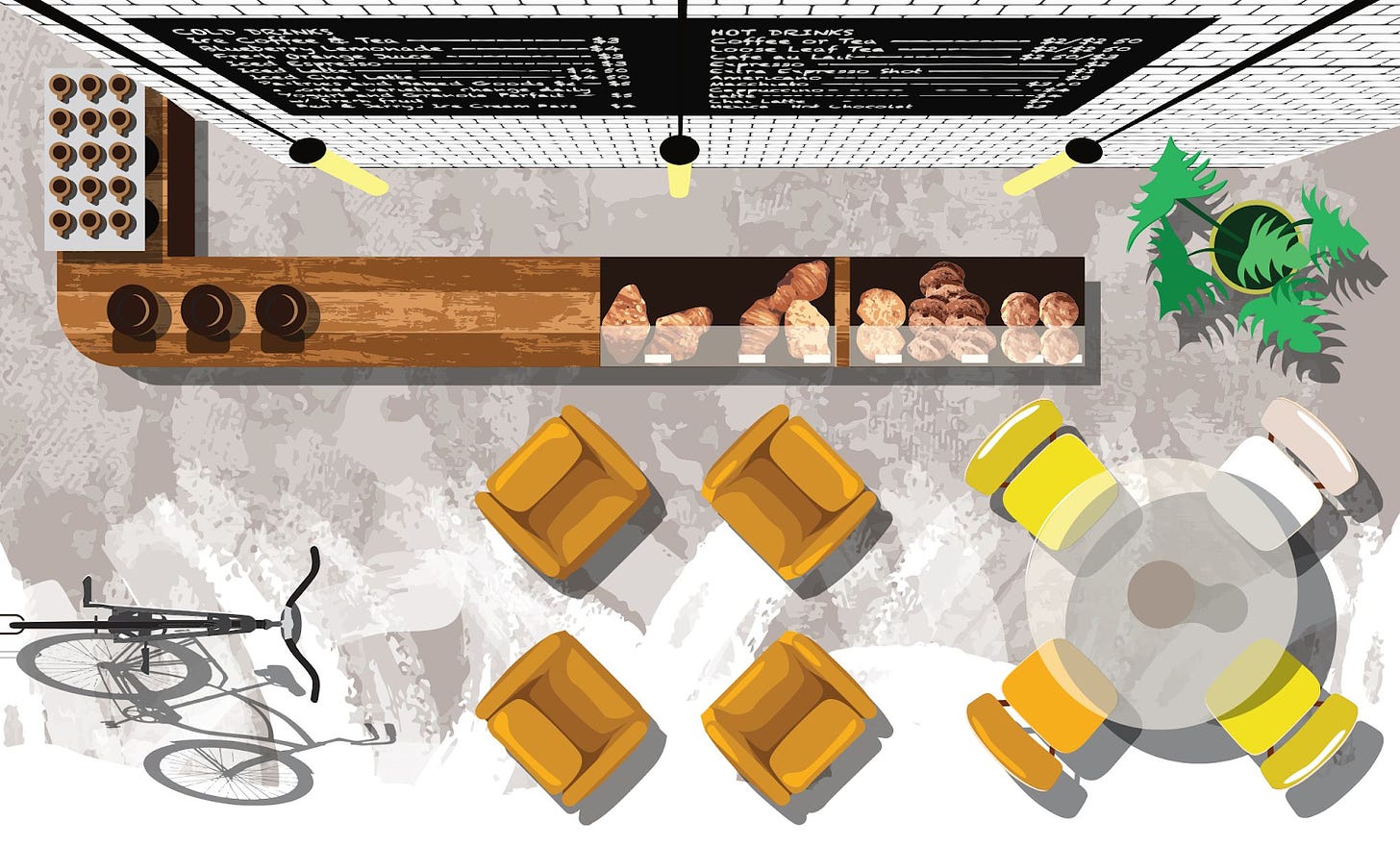 An AirSpace design
An AirSpace designAll of the sudden, a local place becomes the subject of the global gaze. We see the Snap-worthy Museum of Ice Cream, Instagram-friendly D2C mall, and lights-filled AirSpaces wherever we go. Any attempt to preserve the authenticity of a local neighborhood seems to pale in comparison with the economic pull of the market of converging aesthetics and homogenous stimulation. Before we know, physical places start to look uncannily similar to one another. It’s even becoming much easier to find a weird, hidden corner online than to find a physical place that truly feels like one’s own.

Can you tell which city is this? Answer: Showfield’s in NYC.
Now if we look around in the online world, we see a “software designer who likes to browse Twitter with her Matcha latte” town, a “mom who gets a chemical peel facial after Pilates class” town, a “newsletter reading market analyst who checks every hour whether $GME has been squozed” town. These towns emerge quietly but rapidly not because the platforms manufacture these demands in the name of “market expansion”, as many technocrats believe. Rather, these platforms are simply symptoms of massive pent-up demand to address the necessity of picking one’s own destiny in a time of hyper-individualism.
If the First Modernity brought about by the Industrial Revolution suppressed the growth and expression of the “individual” in favor of the “collective”, the Second Modernity arrived with a sobering message: now the “self’ is all we have. Such newfound psychological sovereignty could barely keep up with the efficiency of capital markets. In Capital in the Twenty-First Century, the French economist Thomas Piketty integrated years of income data to derive a general law of accumulation: the rate of return on capital tends to exceed the rate of economic growth (r>g). This dynamic inevitably leaves few much better off than most, and with such divergence comes a range of anti-democratic social consequences. Philosopher Zygmunt Bauman put it best: the deepest contradiction of our time is “the yawning gap between the right of self-assertion and the capacity to control the social settings which render such self-assertion feasible.”
Being the carrier of these societal paradoxes exposes these platforms to immense responsibility, power, and risk. Bearing the “municipal duty” to regulate these emerging “towns” is becoming almost impossible without the adoption of surveillance technology. And for most people, recognizing the cost of empowering these platforms doesn’t abstain us from our reliance on the elusive possibility of belonging.
A friend once asked me: “how many people that you met online have become your close friends?”
I was caught off guard by the question because that’s when I realized how “unnatural” it was for us to become intimately close with people we met from the Internet. As most of the cognitive experiences have migrated online, I realized how I’ve become proficient in materializing memories that were once in pixels into long walks by the Hudson River. The river, and the subsequent Greek restaurant, the Big Gay Ice Cream, and perhaps the Whitney museum, will become a series of coordinates on a map symbolic of the deepening of our tether. The coordinates construct a place that bears meaning that no platform can truly fathom or replace. The collaborative endeavors that will likely follow — be it starting a company that only creates beautiful design, going on a trip to retrace the paths of our heroes, or fundraising for a failing bookstore that we adore — will take place not because we’re both users of the same platform, but because we’ve been local to a place that we’ve always belonged to. The platform simply facilitated such discovery.
The question then is: without these platforms, can we still find our path to one another? If digital nativism becomes the new residential state of the Information Age, how do we build places that foster creativity, reciprocity, and freedom and not be concerned by the invisible hand of an omnipresent ruler? How do we build places that are understanding of our increasingly fluid identities and intolerant of malice?
To answer these questions is to examine a new path into the new frontier of modernity, an alternative to the path that we’re currently rushing towards. There are a few moments in history that you know it’s so significant that it’s impossible to avert your gaze. All the progress we’ve made in the past decades starts to align and give shape to something embryonic but significant, something that could lead to a new path, socially, economically, and politically.

On April 16, 2021, when NSA whistleblower Edward Snowden’s NFT sold for $5.4M on Foundation. The art is named “Stay Free”. The profits won’t go to America’s most famous exiled whistleblower, however. Instead, the sale is meant to benefit the Freedom of the Press Foundation.
The winning bid didn’t come from an individual, but a collective.
It’s from her home in Taiwan that digital artist pplpleasr told Decrypt with confidence the philosophy behind PleasrDAO, a group of anonymous buyers used smart contracts to pool money to buy pplpleasr’s NFT for $525,000. She has since joined as an honorary member and stayed up all night to help the DAO reach the $5.4M to secure the Snowden piece. Strategy Director at Gnosis Kei Kreutler documented how it all went down:
The DAO’s group identity is expressed through their art collection and the actions they take to magnify not the grandiosity of their vision, but the cause behind the art. The seamless coordination among anonymous strangers who share the same purpose inspires others to join in. On the same Friday night that PleasrDAO won the bid for “Stay Free”, Dave White started a collaborative thread, soliciting new ideas for mechanism design with the prompt:
“wouldn’t it be cool if [your DeFi/NFT/other idea]...”
Denis Nazarov, the founder of Mirror, soon responded with an idea called PartyBid. And in a few short days, on April 20th, Anish Agnihotri created PartyBid and shared the Github repo with the community.
All of these experiments are iterating on the mechanism design that brought us closer to a fully actualized vision of DAOs, and PleasrDAO is only one of the many DAOs that have quickly emerged over the past years. Each of them has different design mechanics to reach their respective goals. The significance of PleasrDAO isn’t simply its ability to coordinate fundraising from strangers in a short amount of time, but its laser focus on community contribution. For the past years, the outsized narrative of DAO as an alternative to venture capital dims the light of its much more profound, and much more interesting potential — a fluid, programmable, modular social network that is by design global, transparent, and collaborative. DAO has the potential to become a new frontier of belonging, to create a new species of collective characterized by the alienation of trust from the ownership and control. Calvino, who in his dreams manifest a desire to “possess” a version of NYC, can extend such private desire to a more tangible contribution. DAOs can become a meta-layer on top of the idea exchanges of the world — a second home for those eager to make strides towards their goals, and know that the way to get there is not by oneself, but in a collective.
Digging into the world of DAO feels meta. That’s because, as Brian Lynn tweeted: “Meta-governance is a feature of DAOs, not a product in itself. DAOs as a delegate will be more popular than individuals as a delegate.” DeepDAO, the discovery engine for the DAO ecosystem that received a $1,304 grant from Gitcoin, an open-source bounties platform on the Ethereum blockchain.
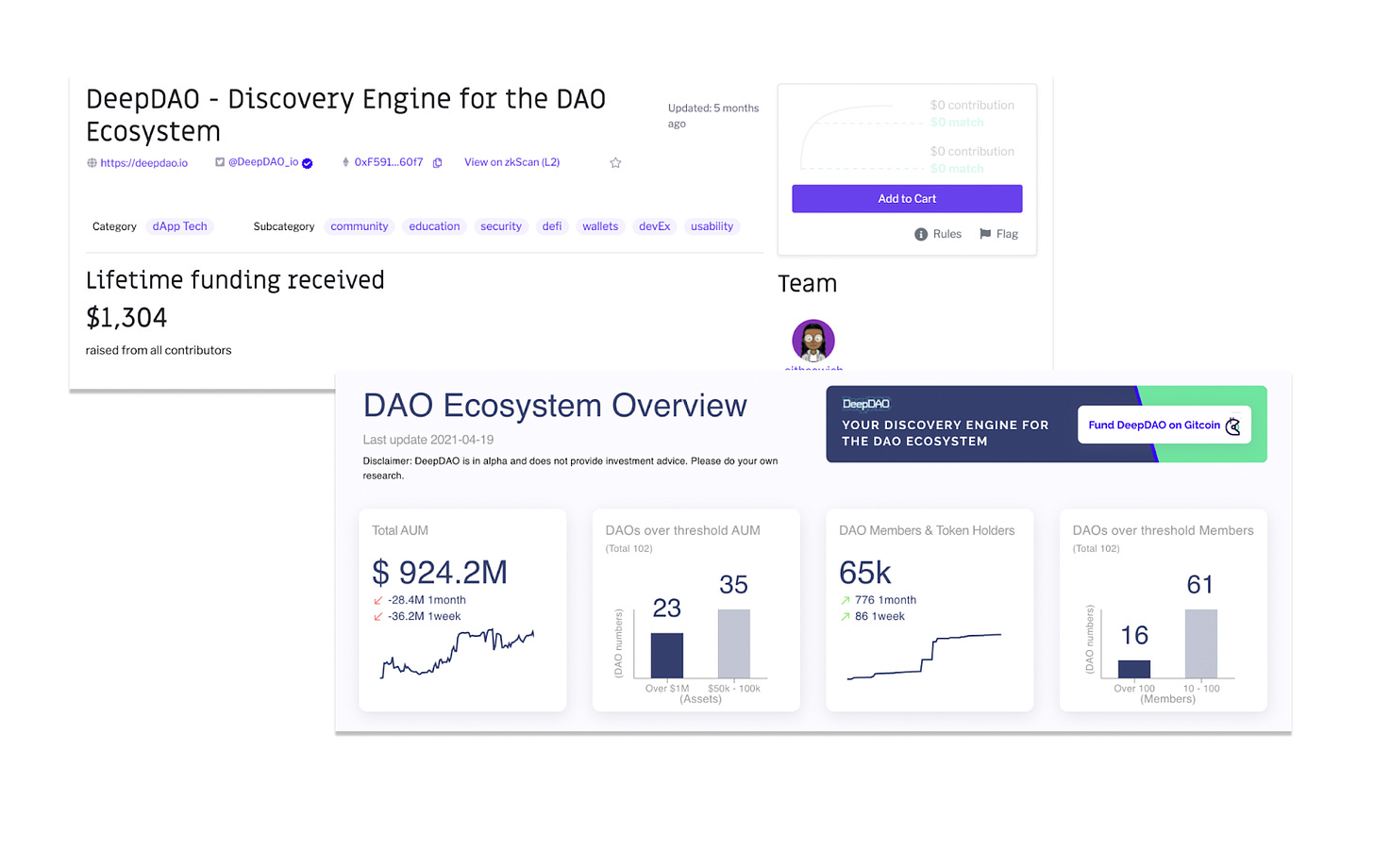
Open source projects, the infrastructure of digital public goods, have long relied on unsustainable funding sources like Github Sponsors, Open Collective, or Buy Me A Coffee. Besides the very few that have reached commercial success by transforming into enterprise SaaS, the vast majority of projects failed to find adequate funding. Open source veteran Dave Glick, the creator of Statiq and Discover.NET, shared in an interview with StackOverflow:
To the extent a maintainer wants funding (and considering funding isn’t appropriate for, or wanted by, everyone for every project), I think the best thing we as a community can do is accept that the status quo isn’t working. If we use that as a starting point, then the next question becomes “what can I do that’s different?” The more maintainers that start looking outside the historically accepted project funding mechanisms and start considering and supporting alternatives, the sooner we can normalize those alternatives and hopefully lift up the entire ecosystem of open developed software.
Since the launch in 2017, Gitcoin helped builders raise and distribute almost $20M through bounties, hackathons, and quarterly grants rounds. Gitcoin Grants is the largest implementation of Quadratic Funding, a radically democratic approach to allocating resources for public goods.
 Source: Vitalik
Source: VitalikThe allocation community’s treasury is also made easy by projects like Llama. With Llama, everyone has visibility into the “payroll” and “P&L” of a community, and any update to the organization’s operation, such as a salary change, could be posted as a proposal on Snapshot.
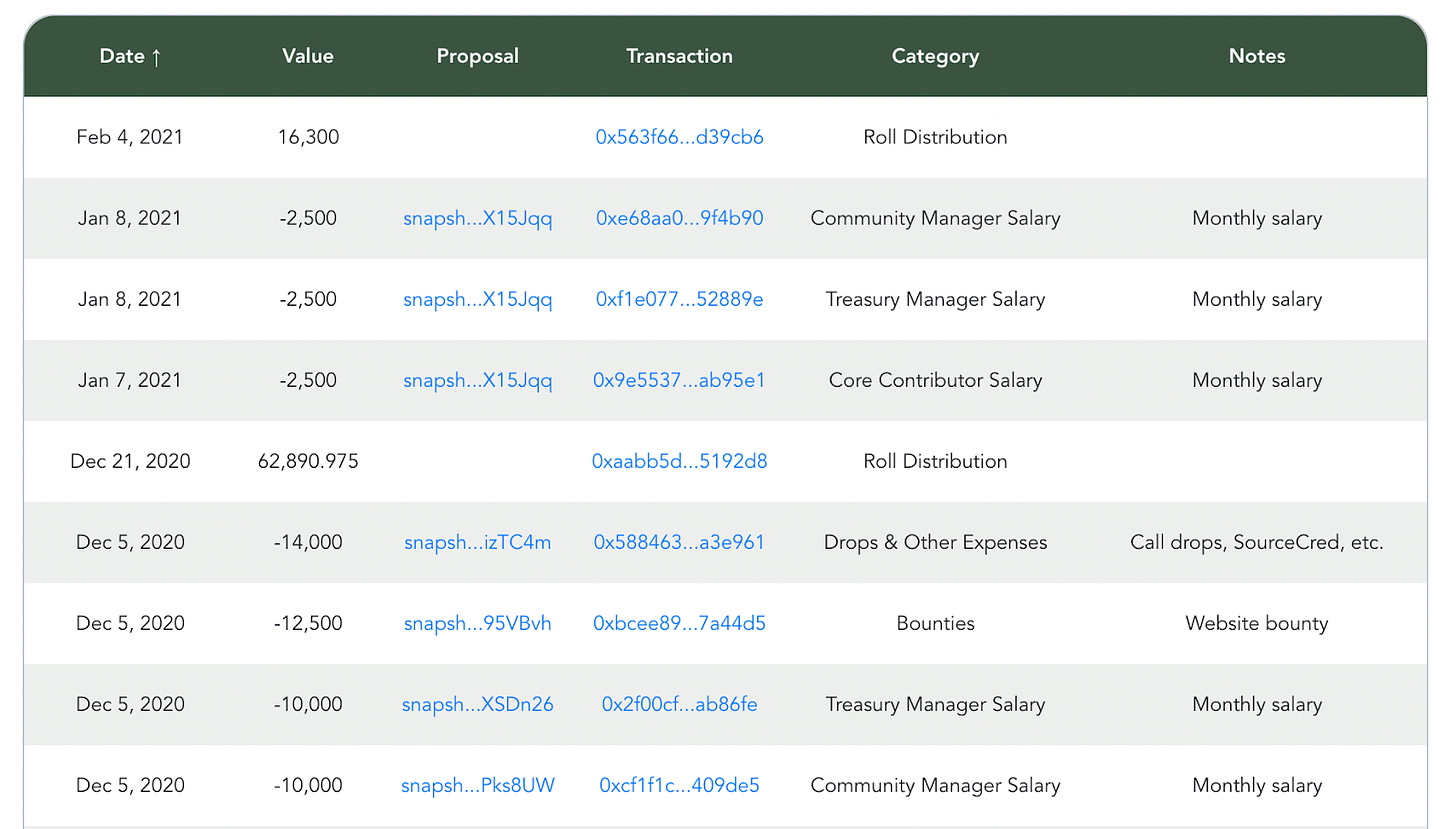
Screenshot from JAMM’s Llama
 Screenshot from JAMM’s Snapshot
Screenshot from JAMM’s SnapshotImagine if a group of gamers that met on Fortnite want to save a pizza joint in Williamsburg that’s about to go under because of COVID. Let’s call it Pizza King. What could they do to save Pizza King?

The objective here seems clear — to raise money to keep Pizza King alive. There’re many ways to achieve the goal. They can create a Twitch stream fundraiser via Tiltify, or set up a store on Nexus and donate all the proceeds.
Maybe the primary objective isn’t just keeping the pizza shop afloat, but to gather like-minded pizza lovers who’re passionate about keeping local flavors alive. What if after a successful fundraising, the group expands its ambition to save all the suffering local pizza shops in the world? What if they want to start a zine just on pizzas, or to make a pizza app for the local business owners to easily sell pre-packaged pizza sauces? With the attention they attracted, more talented members join in, and businesses may desire to work with them to increase brand equity. 20% of proceeds generated can go back to supporting the local pizza shops, 10% can be used to purchase prepaid gift cards at designated shops so that if a member of the Pizza King Squad travels to Paris or LA, they can get a free slice. The rest of the proceeds can be used to compensate prorated based on tokens earned from contribution or be directed into becoming liquidity providers for protocols of choice. The design fund flow can undergo a review process on a quarterly basis.
All the above can happen without Pizza King ever being involved and members ever meeting one another. The rules of governance have been encoded in the genesis of the DAO. We can replace Pizza King with a neighborhood park, a public library, Baldwin’s Cafe de Flore, his distant memories of the neighborhoods in Harlem, or the streets that inspired Calvino’s walks in New York. Regardless of the size and location of the place, everyone can earn their place in it, as long as they have access to the Internet.
In order to make creating DAOs seamless, a suite of governance templates that supports different objectives and structures needs to be in place to smooth the adoption curve and solve for mechanics design-project fit. Making the building blocks of token issuance and minting, incentive design, coordination, treasury, and community engagement more atomized and user-friendly will allow more collectives to assemble configurations of their preference based on their primary objectives. So far, such large-scale distributed efforts are coordinated with a combination of Twitter, Discord/Telegram, governance and voting platforms, synchronous collaboration tools, and asynchronous documentation. The distribution of projects and recruitment of participants still rely heavily on Web2 platforms. A whole green field appears as we glimpse into the future — a fully integrated stack that’s cross-device, lightweight, flexible, and user-friendly.
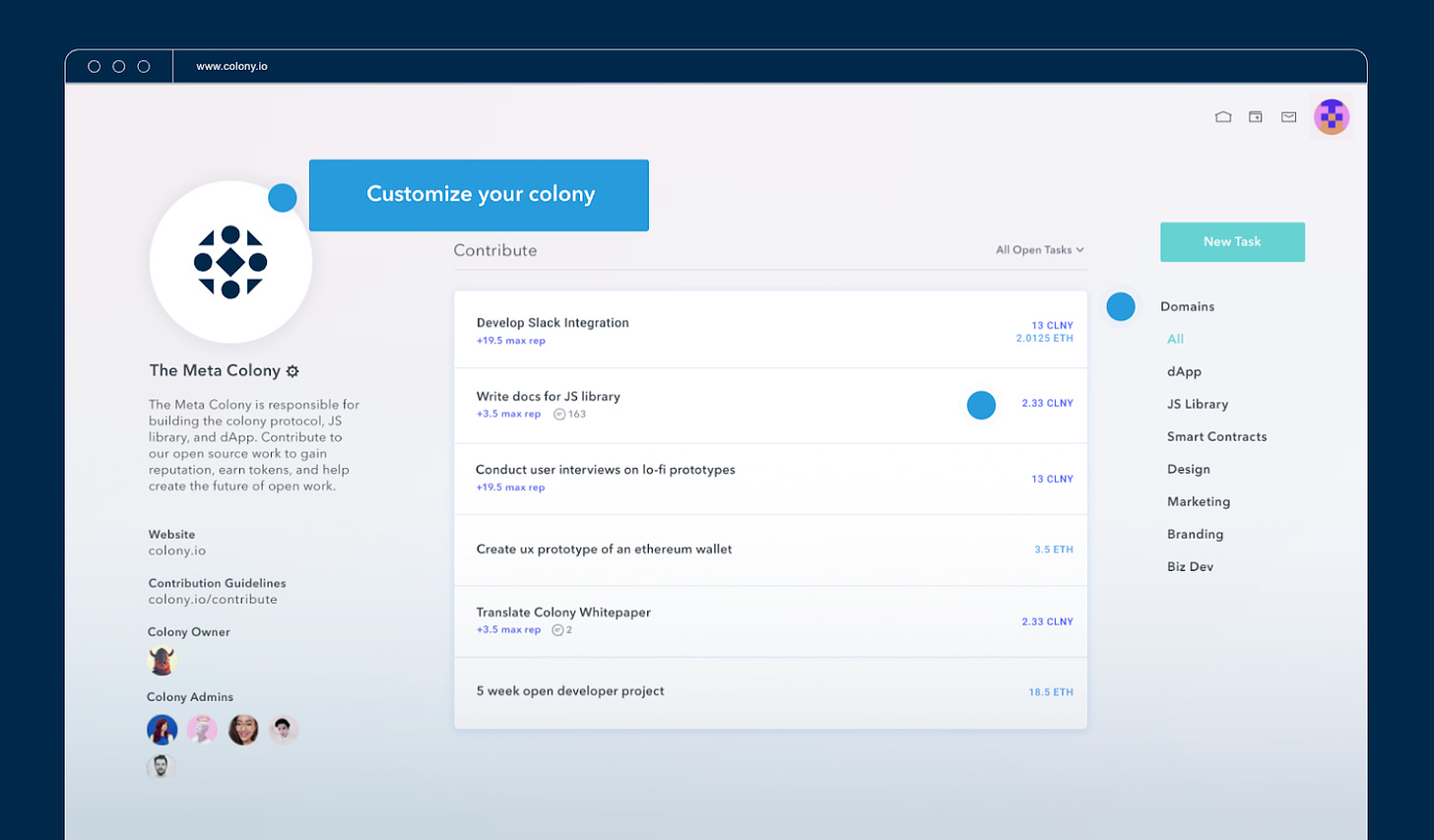 UI of Colony.io
UI of Colony.io
Some of the existing DAO creation tools such as Colony, Aragon, DaoHaus, and DaoStack are all pushing the boundaries on making creation more accessible. They each have their own flavors of governance infrastructure, incentive design, and user experience. We can expect a more in-depth analysis of those platforms at a later date.
As cherry blossoms start to bloom and the skaters in neon green shirts showing off his backside 360 in Washington Square Park, I think to myself once again what it means to be a New Yorker. I think the answer is that being a New Yorker means being universally local. Walking south from Union Square to Greenwich to SoHo to Tribeca to FiDi. People’s outfits are changing, so is my pace. I feel at home through the change of pace, the same way that New Yorkers contain multitudes and different rhythms. By the end of day, we each return to what we call home, and we wish that as long as we’re here, we can contribute something to make the beauty last.
This may be a story about a new species of corporate governance, a better internet, a path to true democracy, a rebel against gatekeepers, and we’re probably on chapter 1 of that story. Yet I hope this is also a story about the modern individualist’s awakening to the power of the collective.
I want to end the post with a beautiful quote from Active Hope:
When hurricanes, floods, and earthquakes sweep away illusions of self-sufficiency, we are reminded how much we need one another, how much we depend not only on people but also on the larger web of life. We treat people with a different kind of respect when we consider that they might someday be pulling us out of the rubble. We treat the rest of life with a different kind of respect when we consider that without it, we wouldn’t be here at all.
We’ve probably never been more dependent on each other. We’ve probably never been more eager to belong. Even as migrants, we can feel local to many homes.